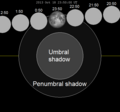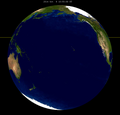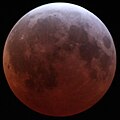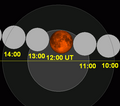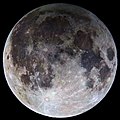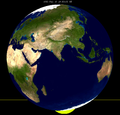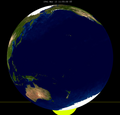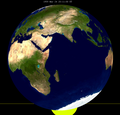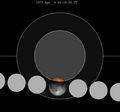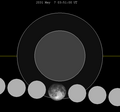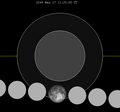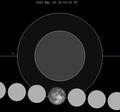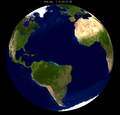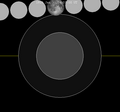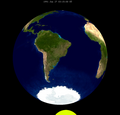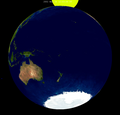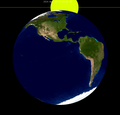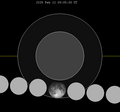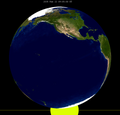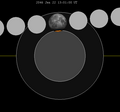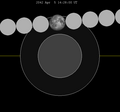Top Qs
Timeline
Chat
Perspective
April 2013 lunar eclipse
Partial lunar eclipse 25 April 2013 From Wikipedia, the free encyclopedia
Remove ads
A partial lunar eclipse occurred at the Moon's ascending node of orbit on Thursday, April 25, 2013,[1] with an umbral magnitude of 0.0160. A lunar eclipse occurs when the Moon moves into the Earth's shadow, causing the Moon to be darkened. A partial lunar eclipse occurs when one part of the Moon is in the Earth's umbra, while the other part is in the Earth's penumbra. Unlike a solar eclipse, which can only be viewed from a relatively small area of the world, a lunar eclipse may be viewed from anywhere on the night side of Earth. Occurring about 1.8 days before perigee (on April 27, 2013, at 15:50 UTC), the Moon's apparent diameter was larger.[2]
Only a tiny sliver (1.48%) of the Moon was covered by the Earth's umbral shadow at maximum eclipse, but the entire northern half of the Moon was darkened from being inside the penumbral shadow. This was one of the shortest partial eclipses of the Moon in the 21st century, lasting 27 minutes. This was also the last of 58 umbral lunar eclipses in Lunar Saros 112.
Remove ads
Visibility
The eclipse was completely visible over Africa, Europe, and Asia, seen rising over eastern South America and setting over Australia.[3]
  |
 Visibility map |
Images

Gallery
- From Melbourne, Australia, 18:42 UTC
- From Las Palmas, Canary Islands, 20:05 UTC
- From Essex, England, 20:06 UTC
- From Arinaga, Canary Islands, 20:07 UTC
- From Foncquevillers, France, 20:08 UTC
- From Belfort, France, combined images
- From Thatcham, UK, 20:10 UTC
- From Zürich, Switzerland, 20:12 UTC
- From Düsseldorf, Germany, 20:13 UTC
- From Paris, France, 20:18 UTC
- From Brescia, Italy, 20:19 UTC
- Time lapsed image from Ladispoli, Italy
Eclipse details
Shown below is a table displaying details about this particular solar eclipse. It describes various parameters pertaining to this eclipse.[4]
Remove ads
Eclipse season
This eclipse is part of an eclipse season, a period, roughly every six months, when eclipses occur. Only two (or occasionally three) eclipse seasons occur each year, and each season lasts about 35 days and repeats just short of six months (173 days) later; thus two full eclipse seasons always occur each year. Either two or three eclipses happen each eclipse season. In the sequence below, each eclipse is separated by a fortnight. The first and last eclipse in this sequence is separated by one synodic month.
Remove ads
Related eclipses
Summarize
Perspective
Eclipses in 2013
- A partial lunar eclipse on April 25.
- An annular solar eclipse on May 10.
- A penumbral lunar eclipse on May 25.
- A penumbral lunar eclipse on October 18.
- A hybrid solar eclipse on November 3.
Metonic
- Preceded by: Lunar eclipse of July 7, 2009
- Followed by: Lunar eclipse of February 11, 2017
Tzolkinex
- Preceded by: Lunar eclipse of March 14, 2006
- Followed by: Lunar eclipse of June 5, 2020
Half-Saros
- Preceded by: Solar eclipse of April 19, 2004
- Followed by: Solar eclipse of April 30, 2022
Tritos
- Preceded by: Lunar eclipse of May 26, 2002
- Followed by: Lunar eclipse of March 25, 2024
Lunar Saros 112
- Preceded by: Lunar eclipse of April 15, 1995
- Followed by: Lunar eclipse of May 7, 2031
Inex
- Preceded by: Lunar eclipse of May 15, 1984
- Followed by: Lunar eclipse of April 5, 2042
Triad
- Preceded by: Lunar eclipse of June 25, 1926
- Followed by: Lunar eclipse of February 24, 2100
Lunar eclipses of 2013–2016
This eclipse is a member of a semester series. An eclipse in a semester series of lunar eclipses repeats approximately every 177 days and 4 hours (a semester) at alternating nodes of the Moon's orbit.[5]
The penumbral lunar eclipse on May 25, 2013 occurs in the previous lunar year eclipse set, and the penumbral lunar eclipse on August 18, 2016 occurs in the next lunar year eclipse set.
Saros 112
This eclipse is a part of Saros series 112, repeating every 18 years, 11 days, and containing 72 events. The series started with a penumbral lunar eclipse on May 20, 859 AD. It contains partial eclipses from August 3, 985 AD through March 8, 1346; total eclipses from March 18, 1364 through August 27, 1616; and a second set of partial eclipses from September 7, 1634 through April 25, 2013. The series ends at member 72 as a penumbral eclipse on July 12, 2139.
The longest duration of totality was produced by member 36 at 99 minutes, 51 seconds on June 2, 1490. All eclipses in this series occur at the Moon’s ascending node of orbit.[6]
Eclipses are tabulated in three columns; every third eclipse in the same column is one exeligmos apart, so they all cast shadows over approximately the same parts of the Earth.
Tritos series
This eclipse is a part of a tritos cycle, repeating at alternating nodes every 135 synodic months (≈ 3986.63 days, or 11 years minus 1 month). Their appearance and longitude are irregular due to a lack of synchronization with the anomalistic month (period of perigee), but groupings of 3 tritos cycles (≈ 33 years minus 3 months) come close (≈ 434.044 anomalistic months), so eclipses are similar in these groupings.
Inex series
This eclipse is a part of the long period inex cycle, repeating at alternating nodes, every 358 synodic months (≈ 10,571.95 days, or 29 years minus 20 days). Their appearance and longitude are irregular due to a lack of synchronization with the anomalistic month (period of perigee). However, groupings of 3 inex cycles (≈ 87 years minus 2 months) comes close (≈ 1,151.02 anomalistic months), so eclipses are similar in these groupings.
Half-Saros cycle
A lunar eclipse will be preceded and followed by solar eclipses by 9 years and 5.5 days (a half saros).[8] This lunar eclipse is related to two partial solar eclipses of Solar Saros 119.
| April 19, 2004 | April 30, 2022 |
|---|---|
 |
 |
Remove ads
See also
References
External links
Wikiwand - on
Seamless Wikipedia browsing. On steroids.
Remove ads






















